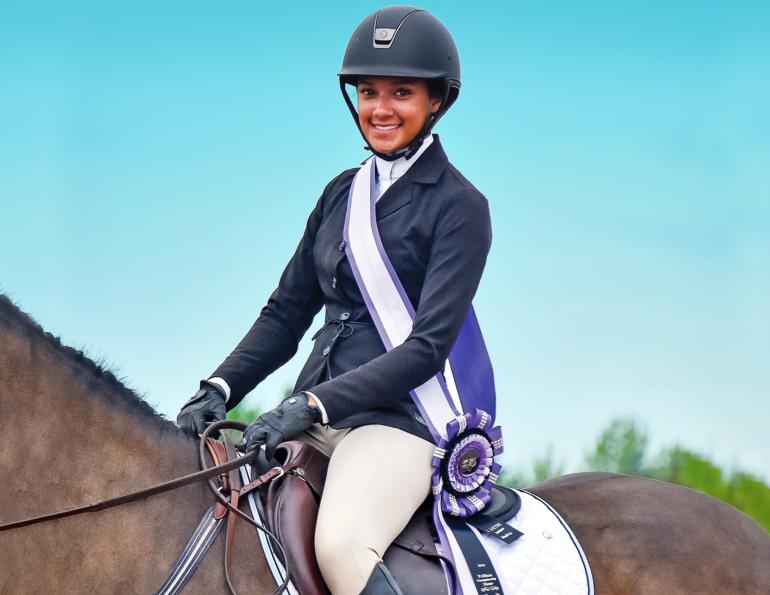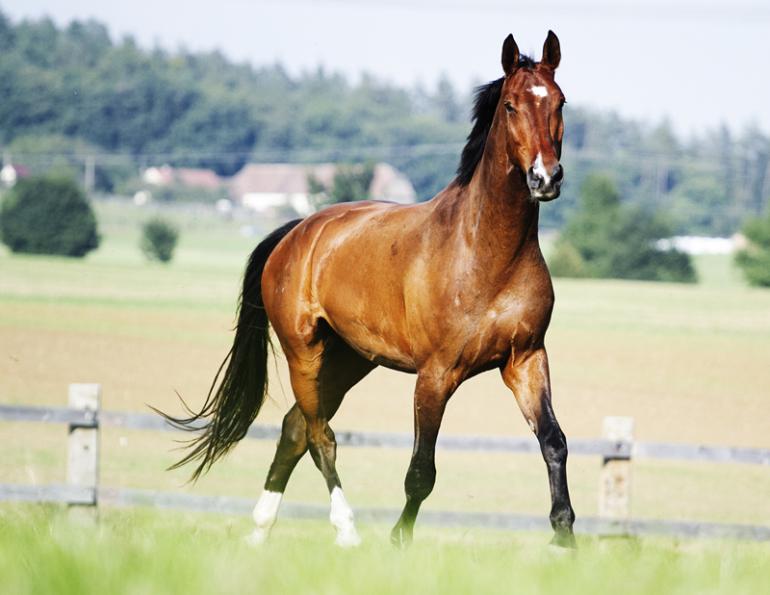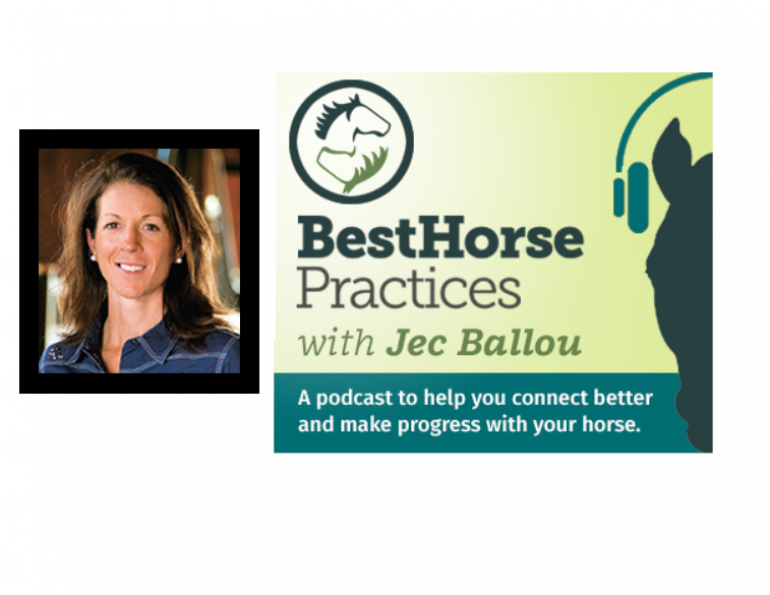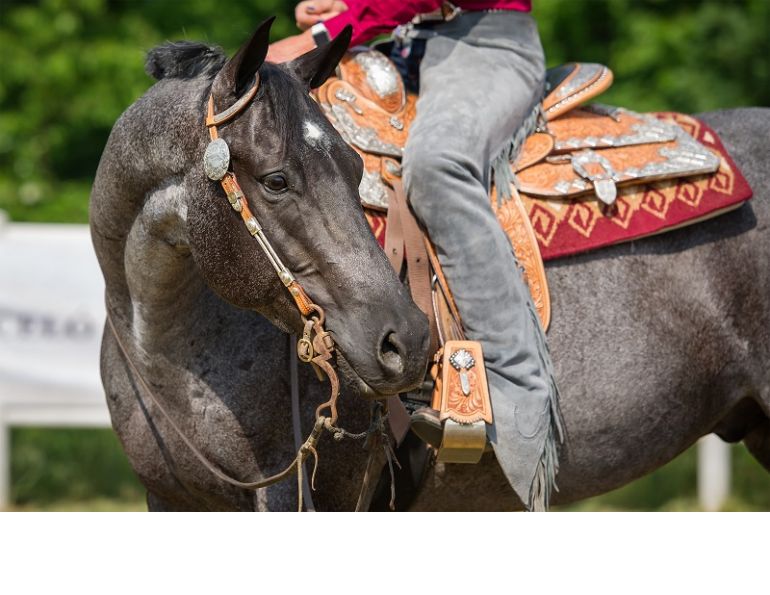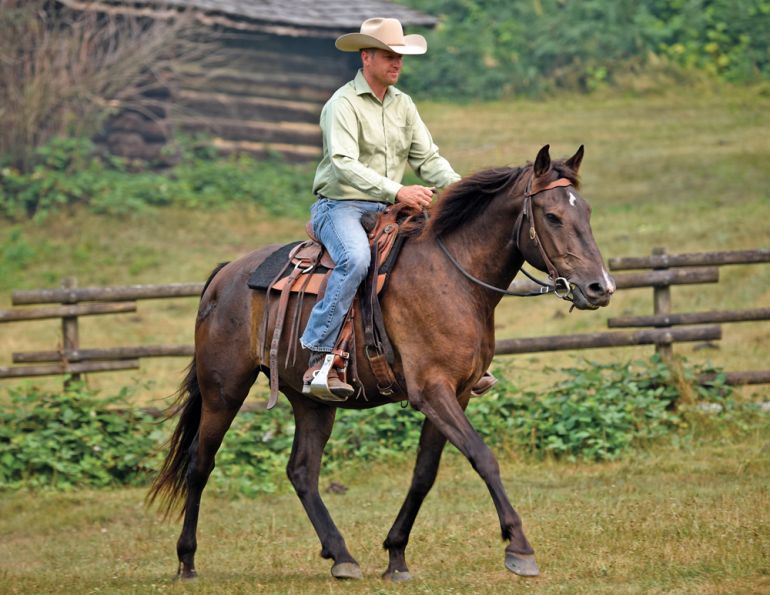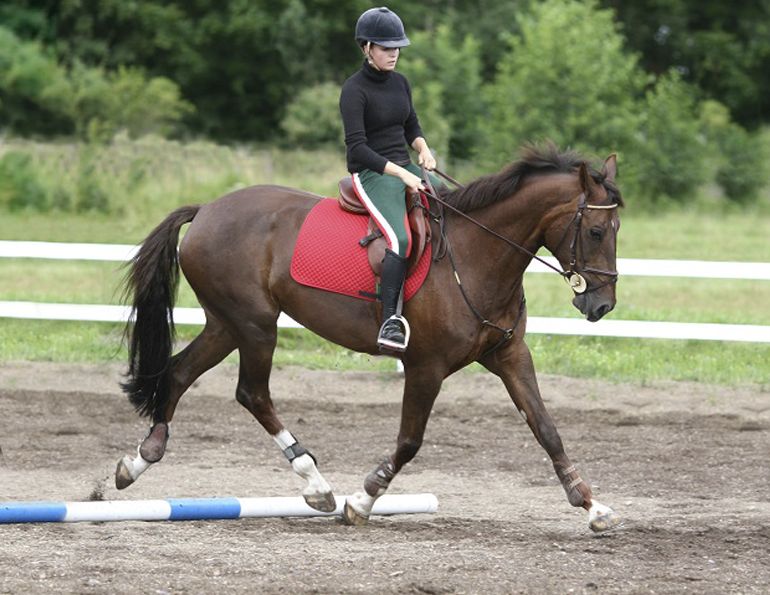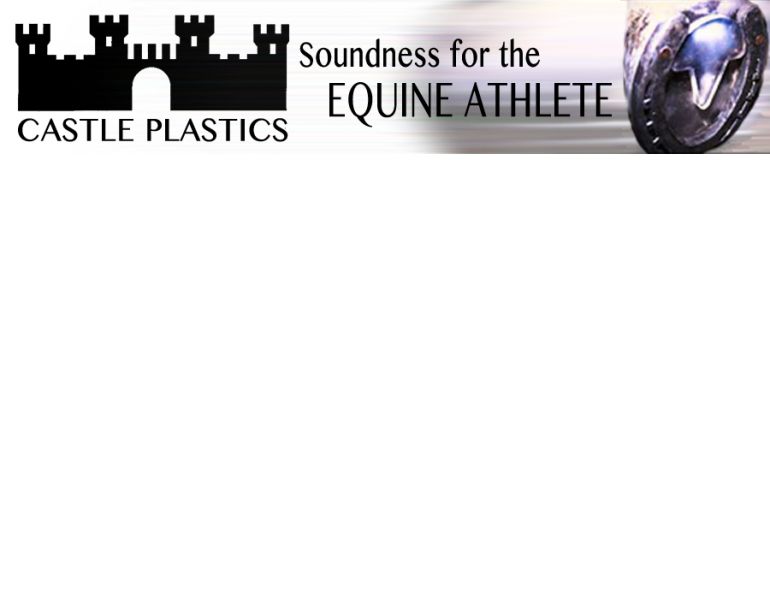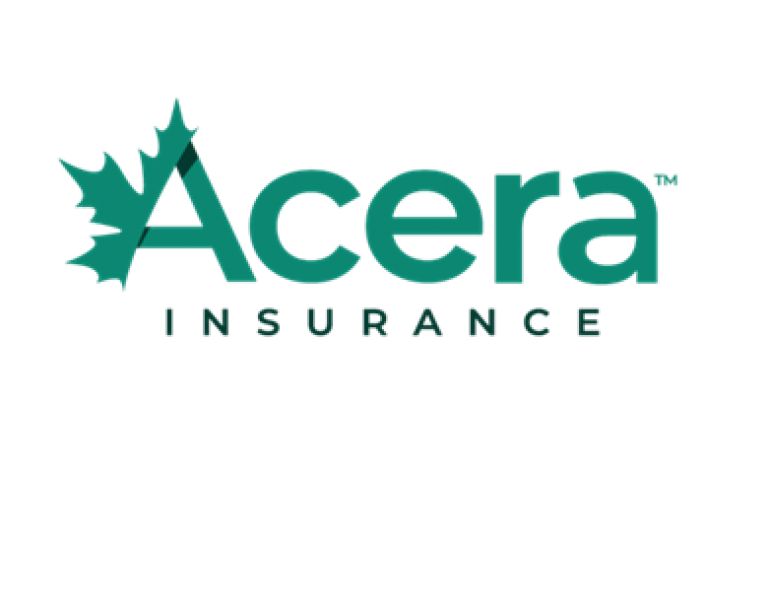Let’s Talk
By Margaret Evans
On May 25, 2020, 46-year-old Black American George Floyd was killed while in police custody, after it was alleged he passed a counterfeit bill. A Minneapolis police officer knelt on his neck for nearly nine minutes while Floyd lay face down, handcuffed, and pleading repeatedly that he couldn’t breathe. Floyd ultimately succumbed. The tragedy struck a chord and protests flared against police brutality and racism — "I can’t breathe" their rallying cry, leading to an ongoing resurgence of the global Black Lives Matter movement.
Black Lives Matter Foundation was formed in 2013 following the acquittal of George Zimmerman, who fatally shot 17-year-old African-American high school student Trayvon Martin. Unprecedented support for the movement has led to a profound uplift in public opinion, with people looking inwardly and examining their own bias while embracing people of colour.
That same self-assertion is rippling through the horse industry, where racism is seemingly less apparent. What is readily apparent is the stark lack of ethnic diversity in the equestrian community. Bias and prejudice have hallmarked society for centuries, but calls for change are now louder than ever, and recognizing that there is a problem is the first step in creating that change.
A Troubled History
When United States President Abraham Lincoln issued the Emancipation Proclamation on January 1, 1863, freeing some 3.9 million enslaved African-Americans in Confederate states, Canada was well ahead of the United States (US) emancipation movement.
According to the Royal Commonwealth Society of Canada, in March 1793, John Graves Simcoe, Lieutenant-Governor of Upper Canada (now Ontario) was shocked to learn of an enslaved woman, Cloe Cooley, who was violently bound, dragged onto a boat, and taken across the Niagara River to be sold in New York State. Knowing that the freedom of all Africans in Upper Canada was at risk, Simcoe lobbied others in the colonial government, and, by July 1793, they passed legislation banning importation of enslaved Africans into Upper Canada. It was the first law of its kind in the British Empire. It led to the abolition of the Trans-Atlantic Slave Trade in 1807, which culminated, in 1833, with the Slavery Abolition Act passed by Parliament in Britain, ending chattel slavery throughout most of the British Empire. It came into effect August 1, 1834.
As a result, the Province of Canada, as it was known then, effectively became a safe haven for thousands of enslaved people in the US who escaped the tyranny and cruelty of their owners. Their safe and secret passage to a life of freedom in Canada launched the Underground Railroad, a network of contacts and access points for escapees travelling north by horseback, horse and cart, carriage, or just walking. Those who assisted in their journeys were abolitionists, but in addition they received help from cavalry members of the Canadian Militia. Documents proving their involvement were serendipitously found by Akaash Maharaj when he was CEO of (then) Equine Canada from 2008 to 2012.
“I only became aware of the role of early members of cavalry regiments in the Underground Railroad during my time at Equine Canada when I stumbled over a few scraps of records,” he says. “They were stored unorganized and unlabeled in boxes containing quite a random assortment of objects and documents. Three pages were lists of supplies being gathered up for a trip that was to begin at a place in Ontario called Fort Malden, to meet someone in the United States who was trying to help people escaping slavery into Canada. One page was from the diary of an unnamed (in the document) rider, who had had an argument with his fiancée about such trips into the United States.”
Fort Malden National Historic Site was the British stronghold on the Detroit frontier during the War of 1812 and the rebellions of 1837-38. The Underground Railroad helped an estimated 100,000 enslaved people find freedom, with some 30,000 fleeing to Canada between 1830 and 1860.
In the late 1800s, cattle ranches were rapidly spreading across the West and thousands of freed enslaved Black people were finding new opportunities as ranch hands. In fact, many historians estimate that one in four cowboys was Black.
One Black cowboy set aside adversity and seized opportunity over a century ago to become one of the most respected figures of his day. Thanks to his hard work and good natured ways, this former enslaved man battled 19th century racism and earned the admiration of his peers. He helped pioneer the foundations of ranching in Western Canada, showing that a single Black life could set a gold standard.
John Ware was born into slavery in 1845 on a plantation near Georgetown, South Carolina. When emancipation set him free, he headed for Texas to pursue life as a cowboy. With first-rate skills in horsemanship, he was soon driving cattle north from Texas to Montana and Wyoming. In 1882, he was hired to help drive 3,000 head of cattle to the North West Cattle Company ranch that became known as the Bar U Ranch southwest of Calgary. Recognizing the huge demand for skilled cowboys in Canada, Ware stayed and, in 1884, began working for the Quorn Ranch, which raised cattle and horses. Ware’s reputation grew and he began to earn great respect among local ranchers as a shrewd cowman, an accomplished horseman, a hard worker, and an all-around good-natured guy. “The horse is not running on the prairie which John cannot ride,” reported the MacLeod Gazette in 1885.
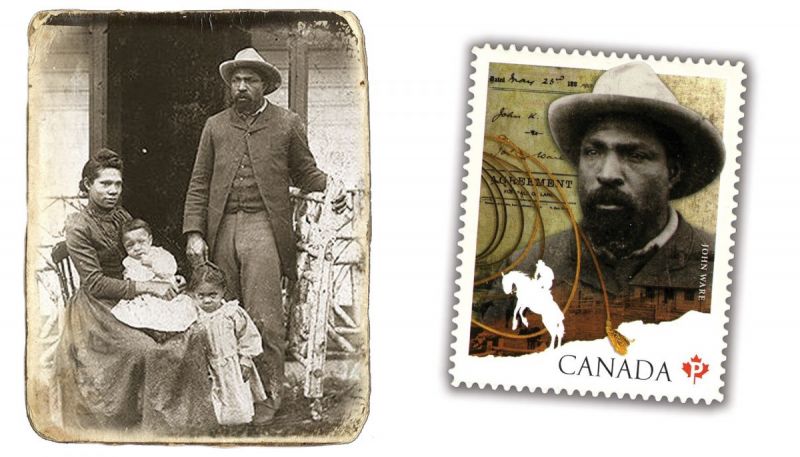
John and Mildred Ware with children Robert and Nettie, circa 1896. Credit: Wikimedia (left). The legacy of John Ware lives on. His compelling story has been the subject of books, a song, and a National Film Board documentary. Several geographical features near the Ware’s ranch are named in his honour. Calgary is home to John Ware Junior High School, and he was featured in a commemorative stamp issued by Canada Post to celebrate Black History Month 2012. Photo courtesy of Canada Post (right)
Ware started his own ranch in 1887 on the north fork of Sheep Creek in the Alberta foothills, and in 1892 he married Mildred Lewis and they started a family. In 1901, Ware and his family resettled northeast of Brooks on the Red Deer River. But tragedy struck in March 1905, when Mildred died of pneumonia and typhoid. The following September, Ware himself was killed when his horse stumbled in a hole and fell on him, crushing him and breaking his neck.
Ware’s funeral was the largest the young city of Calgary had ever seen, attended by ranchers from around the region. Despite being born into slavery, Ware had risen above the anti-Black racism and discrimination of the time, to become a symbol of all that it meant to be a hardworking, trustworthy, talented rancher and horseman, qualities other ranchers respected and admired. Today, Ware remains one of the most respected figures in the history of ranching in Western Canada.
At a time when Black cowboys were riding the Western ranges, Black jockeys were making history on the US racetracks. Decades before emancipation, enslaved boys were used as jockeys. In 1832, President Andrew Jackson, who loved horse racing, brought three promising colts to the White House, along with three Black boys called “race riders,” who were between the ages of nine and twelve. Young Black equestrians, working closely with skittish Thoroughbreds, developed abilities to connect with the horses and focus on the race.
In 1875, the first Kentucky Derby was held in Louisville and, of the 15 jockeys, 13 were Black. According to an article written by Lisa Winkler and published in the April 23, 2009 issue of the Smithsonian Magazine, 19-year-old Oliver Lewis, a Black Kentuckian, rode Aristides, a chestnut colt trained by a former enslaved person, and galloped to victory. She wrote that, of the first 28 Derby winners, 15 were Black. Jockey Isaac Murphy became the first jockey to win the Kentucky Derby three times — in 1884, 1890 and 1891 — and he was the first Black jockey to be inducted in the Thoroughbred Racing Hall of Fame posthumously in 1955.
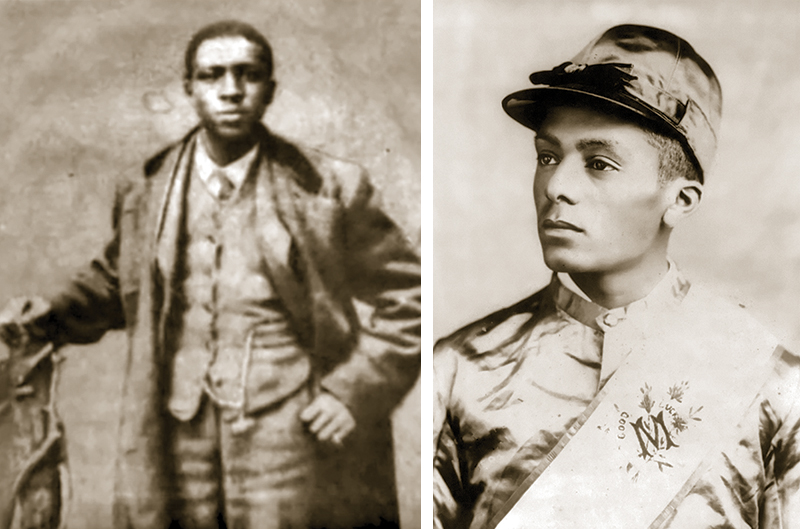
Two of the African-American jockeys who dominated the racetracks in the 1800s were Oliver Lewis (left) and Isaac Murphy (right). Oliver Lewis won the very first Kentucky Derby on May 17, 1875, riding Aristides. Isaac Murphy, an American Hall of Fame jockey, is considered one of the greatest riders in American horse racing history. He rode in 11 Kentucky Derbies, winning in 1884, 1890, and 1891.
But excelling in the sport would lead to their downfall. Bitter racism and the controls of exclusion and prejudice forced Black jockeys off the horses and off the track, as availability of mounts dried up and White jockeys dominated the barns. The last Black rider to race in the Derby during that era was Henry King in 1921. It would be 79 years before another African-American rider, Marlon St. Julien, would mount up; he finished seventh in the Kentucky Derby in 2000.
The harsh reality of racism was equally at home in the military. Buffalo Soldiers were all-Black members of the 10th Cavalry Regiment of the US Army formed in 1866. The nickname came from Native American tribes who fought in the Indian Wars, and who saw in the tightly curled hair of the Black riders a similarity to the coats of plains buffalo.

Buffalo Soldiers of the 25th Infantry, some wearing buffalo robes, Ft. Keogh, Montana, circa 1890. Buffalo soldiers were African-American soldiers who mainly served on the Western frontier following the American Civil War, helping control the Native Americans of the Plains, capture cattle thieves, and protect settlers, stagecoaches, wagon trains and railroad crews.
But appearance did not beat talent. The soldiers were skilled horsemen, so much so that, in 1907 at the US Military Academy in West Point, cadets began learning their riding skills from Black noncommissioned officers who were considered the best. Henceforth, the 100-man detachment would teach future officers riding instruction, mounted drill, and tactics until 1947. Yet, despite their service, racism and prejudice would lead to violence against the soldiers, a lack of recognition for their work, and frequent postings to remote locations to reduce the visibility of Blacks.
Destructive Discrimination
“My grandmother was a professor at Wichita State University and she taught ethnic studies, African-American studies, and so she did a lot of history like the Buffalo Soldiers,” says Philesha Chandler, dressage rider and trainer in Wellington, Florida. “There’s a town in Kansas called Nicodemus and it was the first of what they called a ‘Black town.’ [A town established by African-Americans during the Reconstruction Period following the American Civil War.] Her friend there runs different historical tours and she did the reenactment of the Buffalo Soldiers. I grew up with that knowledge.
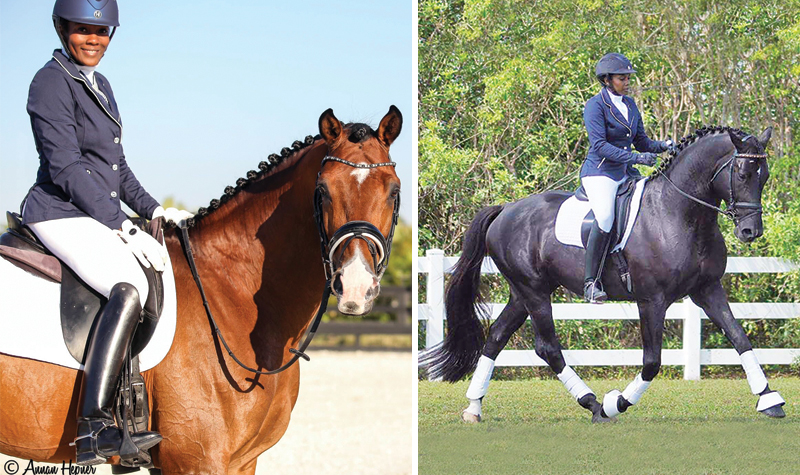
Florida-based dressage rider and trainer Philesha Chandler says she deals with enduring discrimination when offering training services. Photos courtesy of Philesha Chandler, by Annan Hipner (left) and ShaanaRisley (right).
“But being in the horse sports, I didn’t ever see Black people. Most of the time growing up I was the only Black rider at a show or at my barn. I have seen more within the last 10 years being in Wellington. But it is still not super common, especially being a dressage rider. You can count them on one hand. We get mistaken for each other a lot.”
Being Black, Chandler must deal with enduring discrimination when offering her dressage training services. She can train and ride through to the grand prix level. She says that while a White trainer may be taken at face value based on his or her CV, for Chandler getting hired comes from word-of-mouth or after a potential client sees her ride. And success in the training paddock does not always lead to the show ring.
“I had a client who brought me a difficult horse and I got the horse going,” she says. “When he was going nicely the client told me she was going to take the horse and have this other rider ride it because she wanted it to go in the show ring and it would be a good look to have a young blonde ride the horse. I posted this on Facebook and people [actually] defended her.”
Lauryn Gray lives in Oakville, Ontario, and has successfully ridden the Trillium jumper circuit on her mare, Chelsea, a Hackney-Thoroughbred-Clydesdale mix. She began riding at age nine, began competing at age 10, and now, as a 17-year-old Black rider, she is acutely aware of the need to speak out against oppression and in support of the Black Lives Matter movement. For Gray, staying silent is not an option.
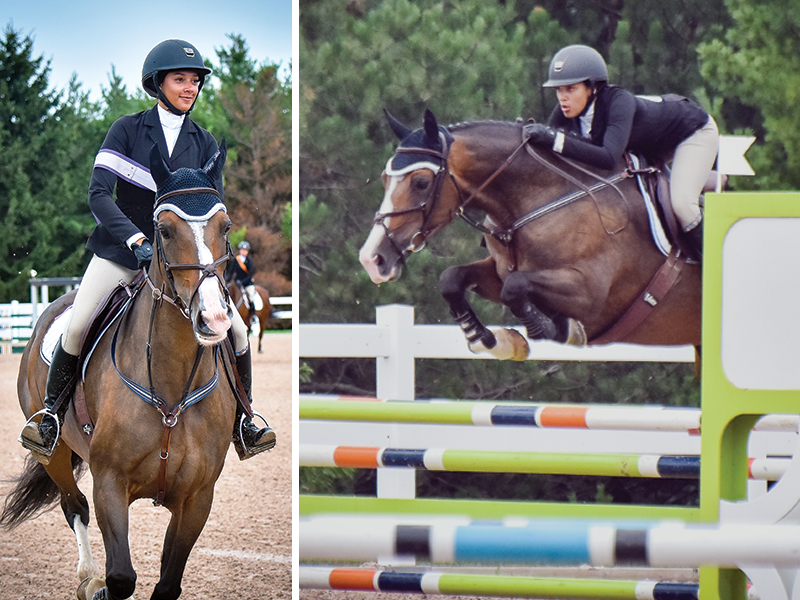
Lauryn Gray believes that staying silent is not an option. She wants to see people of colour better represented in the horse industry, and racism acknowledged so people start talking about it. Photos: Karie Elizebeth Photography
“Large equestrian groups are starting to become a bit more aware of how under-represented we are, and they highlight riders of colour and Black riders,” says Gray. “Living in Canada is different than what people may be experiencing down south in the United States. For me, I have always been accepted. I can’t speak for everyone who is a person of colour in the equestrian world; I can only speak on behalf of myself. But I know in my personal experience that I have been accepted, and I would like to think that always happens, but I know that’s probably not the reality.”
Mya Brathwaite is a 16-year-old Black equestrian based in Toronto. She rides the hunter circuit and owns High Horse Equestrian, a new company offering eco-friendly equestrian clothing. Like Gray, she has a heightened and sometimes troubling awareness of being Black when so many in the equestrian world are White.
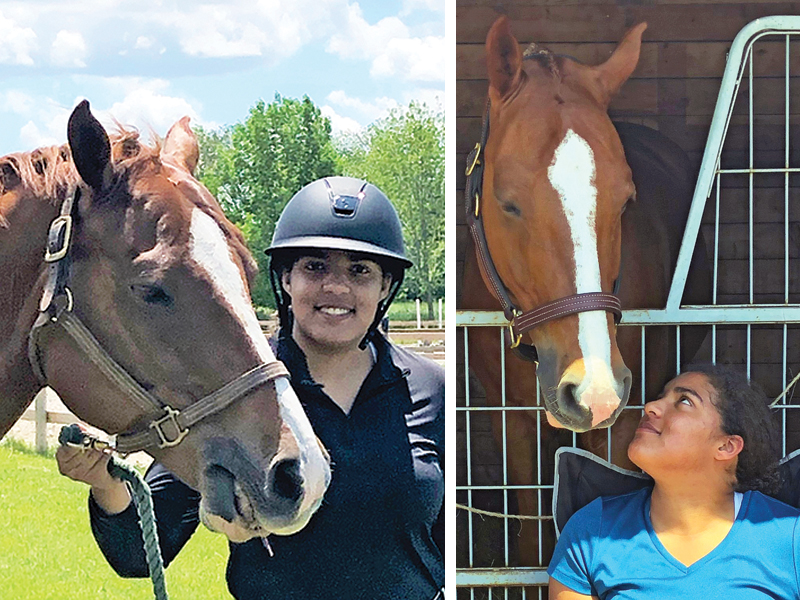
Mya Brathwaite believes that to be a rider of colour one must be strong. “It’s very uncomfortable to walk into a barn or go to a show and everybody you see is white.” Photos courtesy of Mya Brathwaite
“I think it is more of a social thing than a cultural thing because I’ve heard a lot of people ask, You ride horses? [as though] it’s not so much a socially acceptable thing for Black people to ride. Also, it’s very uncomfortable to walk into a barn or go to a show and everybody you see is White. My barn where I ride right now is so welcoming and supportive, but I find that a lot of riders have come from a wealthy background so some comments they make are very ignorant. I feel that’s another reason why people of colour don’t choose to take up riding, because they feel like they won’t be understood by other people who ride.”
Brathwaite believes that not everyone is bad and nobody truly wants to hurt other people, but comments that come from a lack of understanding highlight the fact that they have not had to think about what they say or how to say something to a Black person. And that can come from an upbringing lacking in awareness.
Gray’s message is that now is not a time to stay silent, but to join the global movement to raise that awareness.
“A lot of people stay silent because they think it’s not their place to weigh in,” says Gray. “They don’t feel comfortable. But the whole situation is an uncomfortable one. It’s important that people use their voice to raise awareness. If you are not saying anything, even if you have good intentions, you are doing more harm than good. You are contributing to the oppression. I feel I have a responsibility to talk to people about it because even where I live — Oakville — it is a predominantly White city. The majority of the people in my school are White, so I do feel I need to speak up about these things in my friends’ group and the equestrian world, everywhere I can.”
That need to speak out has reached into the halls of Equestrian Canada (EC). A working group has been formed to start the conversation about Black people and people of colour becoming a greater part of the equestrian community, and to ensure the issue of racism be addressed head-on.
The Missteps of Management
Maharaj, whose ancestry is from India and whose family came to Canada via the Caribbean, is an accomplished horseman. He was a member of the Governor General’s Horse Guards, as well as a triple gold medalist in Tent Pegging, a highly popular cavalry skill-at-arms sport. It is one of the ten official disciplines under global or regional governance recognized by the International Federation for Equestrian Sports (FEI).
“Undeniably, I encountered increased racism in the [equestrian] sector when I became CEO of [then] Equine Canada,” he says. “But that is a common experience for any member of an ethnic minority who takes on a position of public leadership, in any sector. However, I think it is telling that most of those incidents were covert. The perpetrators tried to mask either what they were saying, or who they were. Despite being a triple gold medalist, people would occasionally claim that I was ‘not a real horseman.’ Despite being born and raised in Canada, people would occasionally complain that I was ‘not a real Canadian.’ Typically, these slurs would come from those cowering online behind false names. I do not believe that they represent a meaningful share of the equestrian community. They only spent an outsized share of their time spewing vitriol. Moreover, I think it reflects positively on our community that most of them felt the need to hide what they were doing or who they were. They knew most Canadian horse people would recoil from their actions.”
But since leaving EC, Maharaj says he has been taken aback by many of the federation’s policies. During his tenure the organization had 75,000 members of which 3,000 were from ethnic minorities.
“But in 2015, EC abolished grassroots membership altogether and replaced it with its elite model of only 27 [voting] members, all of whom are White,” he says. “EC shut down the Aboriginal Riders’ Cohort, the only initiative to increase Indigenous participation in horsemanship, before the program had accepted its first student.”
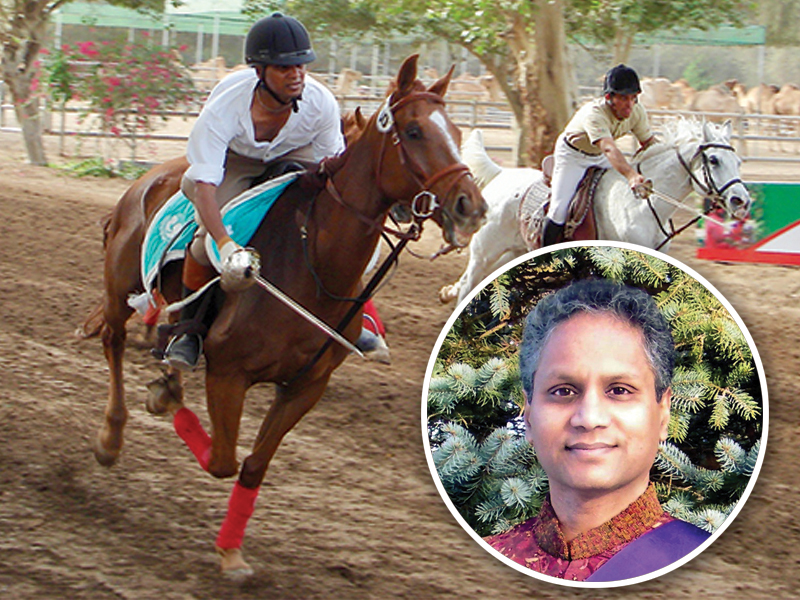
Akaash Maharaj is a former CEO of Equestrian Canada (2008–2012) and a triple gold medalist in tent pegging. “I want to be judged on my personal merits, not my demographics. Racism in Canada tends to be more subtle and more covert; it knows how to speak the language of virtue, even as it commits sordid vices.” Photos courtesy of Akaash Maharaj
Throughout his tenure, Maharaj and his colleagues lobbied for a Canadian postage stamp celebrating John Ware.
“He is the subject of songs, a play, and a film,” he says. “There are at least three geographical features and one public school named in his honour. The stamp was released three weeks after I stood down from EC, but EC never acknowledged the stamp nor John Ware himself. The articles prepared for the website were never published. The social media posts were never issued. The federation has acted as if the man and his work never existed.”
Maharaj prefers to believe EC’s missteps have been out of blindness not malice but, at the same time, he believes they do not reflect the will of the equestrian community and are unworthy of Canadians’ better traditions.
A positive move toward diversity and inclusion of all people of race and colour has been a focal point with both the United States Equestrian Federation and the British Equestrian Federation (BEF).
In June, 2020, the US Equestrian Board of Directors approved the development of a Diversity and Inclusion Action Plan, with the commitment to “providing access and opportunity for people of colour, the LGBTQ+ community, veterans and active military personnel, people with disabilities, and those of all ages, religions, ancestries, and genders and gender identities to harness the synergy of diverse talents.”
The BEF has had in play the principles of equality of opportunity for a number of years. Their mandate is that no individual “receives more or less favourable treatment on the grounds of age, sex, gender, disability, race, parental or marital status, pregnancy, religion or belief, sexual orientation and gender reassignment. This includes all those involved in different capacities across the industry — participants, employees, coaches, consultants, owners, officials, volunteers, and spectators.”
BEF has worked with a number of groups to promote inclusion in equestrian sport but, like many organizations, they are aware that racial diversity is not an area where equestrian sport is strong.
“Racism has been a topic of concern for many organizations within Canada and around the world for quite some time,” says Meg Krueger, president of Equestrian Canada. “Recent events have put a new focus on this, especially movements like Black Lives Matter and all the public commentary and protests in the last [few] months. We are dealing with a problem that has been around for a long time, and now we are working on accelerating this within our own organization and the sport in general. We’ve got the working group but, number one, we are taking a really hard look at ourselves, which is a critical step. To engage in these conversations, we need to recognize what we do well and, also, where we’re failing our community and from that we want to see growth because we want to see our sport grow. All Canadians can participate regardless of their heritage or colour.”
Krueger agrees that, basically, the equestrian community has failed in embracing Black people and people of colour.
“Recognizing there is a problem is a critical first step in this journey of creating permanent change, creating a cultural change.”
That change must include recognition of an unintentional bias to avoid falling into a gratuitous trap.
“The importance of having an effective conversation with our community or partners, whether affiliates or demographics in our community, is so critical because, in those discussions — and we know they can be difficult — we can have some forums where we can openly listen and hear and not be defensive,” says Krueger. “We need to understand where everybody is coming from and the experiences they have had and, through that dialogue and open conversation, we can address unintentional bias.”
Overcoming Bias
Unintentional or unconscious bias is defined as an attitude toward stereotypes or beliefs that affect people’s actions in a discriminatory manner and, often, contrary to their original intentions. Recognizing a bias is the start of mitigating it.
“I have had my barn for over six years,” says Chandler. “People would show up at the barn to try and sell a supplement or another equine product. They would look straight past me and go to one of my White clients thinking they are in charge and it’s their barn, only to have them point to me. Usually they feel kind of embarrassed. Bridging that cultural divide depends on the person. If they are honest with themselves, they will immediately apologize and go out of their way to try to accommodate you because they don’t want to admit to the mistake. They try to make it right in other ways.”
Abriana Johnson lives in North Carolina, and is an author and entrepreneur with a career in large and small animal veterinary fields that has expanded to her interest in animal assisted therapy and education, largely through the addition of her Miniature horse, Encore. She cohosts the Young Black Equestrians Podcast, a platform highlighting the passion, culture, and lifestyle of Black horsemen and horsewomen. She has authored the children’s Cowgirl Camryn book series that focuses on Black cowgirls and Black cowboys. She is acutely aware of the additional challenges facing Black people in the day-to-day barn experience. And it’s here, in first impressions, where the horse industry can fail.
“[With a] barn manager or trainer, nobody is really seeking out Black people,” she says. “I’m not saying it’s a burden, but if you have someone who wants to come out and see your barn and they are people of colour, the dynamic changes. You don’t get the full tour. The assumption is that they can’t afford this lifestyle. There might be a snide remark like, ‘You don’t have a helmet that can fit over the hair of the little girl who wants to ride.’ That changes an experience, and it will make or break whether someone will continue to pursue this.”
Brathwaite totally relates to Johnson’s concerns.
“I feel there’s a lot of microaggression in the equestrian community,” says Brathwaite. “An example of this would be putting your hair up in a helmet. People who wear headdresses or headscarves or hijabs, how can they wear them safely if they don’t make helmets big enough? I got my hair done recently in micro braids, and it was so hard to find a helmet that would fit. It’s times like that when I realize the equestrian market and equestrian social norms are not inclusive enough. They don’t include people of colour. You have to be so strong to be a Black rider. Before I got my new horse Henley, I was so scared to go to a show, especially in rural communities, because I was afraid that I’d be stared at or looked at. [People would think] she’s different, she’s not the same. Why is she here? I’m not riding to stand out. I’m riding because I love horses and I love the sport.”
That strength is found in layers of the horse community seldom recognized by White people. For instance, Brathwaite points to equestrian advertisements in magazines as an example where everyone featured in an ad is White. “You look at other sports [football, baseball, basketball, track and field] and there is so much more diversity.”
That diversity can be the breaking point for whether or not Black people consider riding.
“My takeaway, just from experience, is that people don’t go where they don’t see themselves,” says Johnson. “You have those trailblazers who do go and do things anyway. I’m one of those people. But not everyone is like that. That’s not an expectation we should place on everybody. I feel like there are a lot of ways that this kind of exemplifies itself, but it comes back to the roots, representation. You have riders out there studying other riders. It’s a very subconscious thing, but if you don’t see someone who is like you doing something that you want to do, there’s not always that thought conversion.”
She fully understands the socioeconomic status of participants in the horse industry, but an individual’s financial position is not necessarily why Black people don’t participate in riding.
“As a person of colour, I am past the point of defining racism or defining inclusion or defining diversity,” says Johnson. “You can go to the dictionary for that. We aren’t talking about whether or not this exists. We know it exists, and if your question to me is, Does this exist? then I know you are not ready for the conversation on how to change it. It’s not a definite question anymore. It’s not necessary to be a question in the first place. Let’s stop defining and determining where racism exists. It’s in the fabric of the Western world, period.”
Brathwaite takes a cue from her teacher in applying a philosophy to the Black person’s experience. “My English teacher says, ‘You don’t know what you don’t know.’ I have applied that a lot to how people think. Sometimes they say something, and I’ll think that they don’t know the full extent of what they are actually saying.”
Johnson cautions that just because people are now talking about inclusion does not mean it’s going to happen right away. She sees this as work to be done for the next generation. People of colour are not asking to be treated any better than anyone else. Equality means being treated exactly the same to the extent that people do not even need to have the conversation or the thought process.
A common observation among the people interviewed for this article was how few Black people and people of colour are represented in the horse industry, and how aware they are of being Black in a sport dominated by White people. When looking at riding centre locations across Britain, over 96 percent can be found in areas with lower than average ethnic diversity.
But then there is Brixton, south London, UK. For decades, the city gained notoriety for its riots, youth crime, gun crime, drug crime, unemployment, and poor housing. Yet, now, as a multicultural Afro-Caribbean community, it is rich in diversity, entertainment, food markets, bars, pubs, and nightclubs despite the enduring crime.
And right in the middle of town is the Ebony Horse Club. This little barn offers an equine refuge for young people who routinely experience racism in the city.
“We have seven horses at the moment,” says Naomi Howgate, manager. “Most of them are cobs, black and white, or brown and white. They are so bombproof. They do everything from beginner and lead rein to cantering and jumping. They have great characters and good, sound heads on them. We have the arena and a little bit of turnout space, maybe a quarter of an acre. They can’t race around but they can get their heads down. We are situated in a park so we can ride them out there.”

Riders at Ebony Horse Club in Brixton, south London, UK, where horses help to raise the education, life skills, well-being and aspirations of young people from disadvantaged communities. Photos Kim Lomax/Ebony Horse Club
Ebony Horse Club was formed 24 years ago, and what sets it apart from so many barns is that 75 percent of their students are non-White, many of them male, coming from low-income households in an area of high inequality, where knife crimes and youth crimes are daily occurrences.
“We operate year-round, 9 am to 5 pm,” says Howgate. “We have 150 kids a week and they range in age from eight years to early adult. Fifty of them are on the rolling program, which provides lessons either six weeks at a time, or twelve weeks at a time. They become permanent riders. We fundraise for the lessons, although parents do pay a little bit, about £3 ($5.25) for a 30-minute lesson.”
Howgate thinks of Ebony as a horse haven for many Black riders, some having gone on to stunning success. Khadijah Mellah learned to ride at Ebony starting in 2012 and, in April 2019 sat on a Thoroughbred horse for the first time. Just four months later in August, the 18-year-old made history as the first person in the UK to ride in a horse race wearing a hijab when she won the Magnolia Cup, an all-women charity race. She was both the youngest and the least-experienced jockey in the field.
But for most, Ebony is a place for young people to make friends in a safe location, get help with their homework, and get involved in the walk days or picnic evenings. They also get support when having to travel home.
“In winter it’s dark by five, and they ask if we can walk them home or walk them to the bus stop,” says Howgate. “I always thought they were scared of the other kids and stuff. But they are scared of being stopped and searched by police. Any kid who looks 14 and isn’t White will be searched for knives and asked questions. Can you imagine being scared of the police so you can’t reach out to them for help? I don’t think it’s that the police are going to get violent; it’s just that it makes for a really bad experience. They might not be involved in anything themselves, but they know what is going on. They all know people who have been involved in something. They have lots of big things to deal with.”
To get them away from the pressures, the students are taken on frequent trips to the countryside, shows, and events.
“We’ll do something like a barbeque at a farm, or visit a professional horse barn, or go on a trekking trip to Wales,” she says. “All of that is incredible for them. We’ve had our kids say that they didn’t believe these places existed, they had never seen green fields. At the shows we take them to, there are no Black kids. Yet all the other riders are so kind and encouraging because they know they are coming from Ebony with a different riding background. At one of the shows we did last year, I was walking the jumping course with them. One of the boys said, “You’ve put us in the wrong class.” I asked him what he meant. He said that this was a girls’ class. There literally weren’t any boys riding as riding is so female-dominated, especially at the lower levels. Other riders came from other barns and the classes were dominated by White girls. They are sensitive to seeing riders who don’t look like they do.”
Some of the riders have been on protests in support of the Black Lives Matter movement, something they are passionate about.
“It’s that lack of representation [of themselves],” said Howgate. “Racism can be subtle. It’s the silence. You don’t see riders of colour on magazines, at competitions, or at the Olympics.”
Breaking Barriers
Johnson questions why society still does not have answers to systemic racism.
“Maybe it’s been there so long,” she says. “I was always pushing down barriers. That’s what it’s going to take now. Having these conversations and not letting them go by the wayside is what it’s going to require. We have to do everything in reverse to break down the pattern so that it no longer exists.”
Krueger understands the need to have Black, Indigenous, and people of colour participate in the EC working group to engage them in creating a decisive path forward. To that should be added people who identify with LGBTQ2.
“That part has begun, but it is still in its infancy,” she says. “There’s lots of work to do, but we want to make sure we do it correctly and that it is reflective of everybody.”
Gray fully believes that the main point of acknowledging racism in the equestrian industry is to spark a conversation, and get people talking about these issues.

A happy rider at Ebony Horse Club in Brixton, south London, UK. Photo: Kim Lomax/Ebony Horse Club
“We can’t let things be ignored or silent anymore. Our world is rapidly changing. We have to understand and have more of the present situation in the discussion about the Black Lives Matter movement, and speak up for the people who have greatly contributed. We owe it to them to give back to their communities.”
Brathwaite believes that White people need to address themselves and their past perceived biases to bring about change.
“They need to reflect on what they have done in the past that would be considered racist, sometimes without realizing it,” she says. “You have to listen to what Black people are saying. People want to hold on to past opinions, but how do you develop as a person if you don’t think and see things from other people’s points of view? We need to make it more OK in society to be wrong. In a conversation with someone [try to explain] that what they are saying is hurtful or malicious.”
Maharaj believes that individual equestrians and groups will need to take up the mantle of leadership if meaningful conversations are to happen. But he knows that conversations about race and racism are never easy. They can be embarrassing and intimidating. Maharaj says that he still feels uncomfortable discussing his own ethnicity and his experiences of racism.
“In part, it is because I want to be judged on my personal merits, not my demographics. Racism in Canada tends to be more subtle and more covert; it knows how to speak the language of virtue, even as it commits sordid vices.”
Going forward, he believes that meaningful conversations are possible only if everyone who is able to contribute is invited to the table, and if there are particular efforts to include people whose voices have not previously been heeded.
“We will survive as a community only if we act together as a community, and that begins with finding the courage to see ourselves as we are rather than as we might imagine ourselves to be.”
Photo: Lauryn Gray. Credit: Karie Elizebeth Photography



